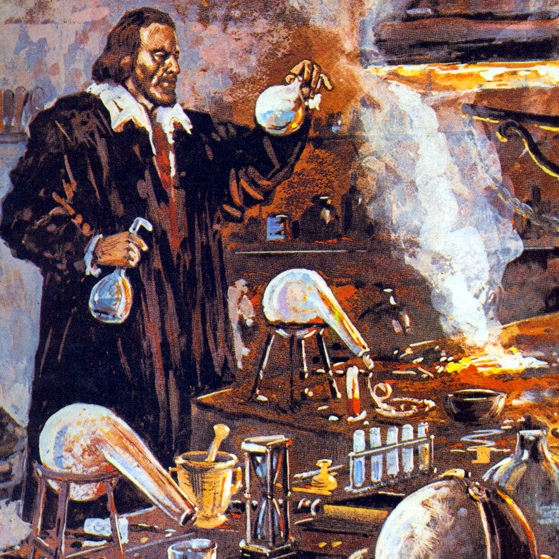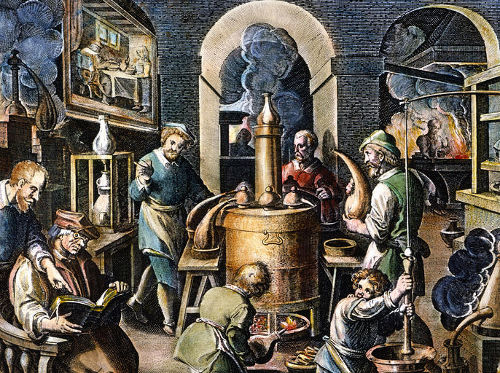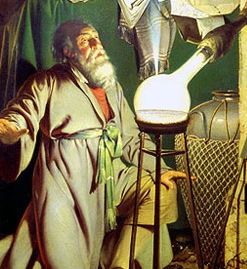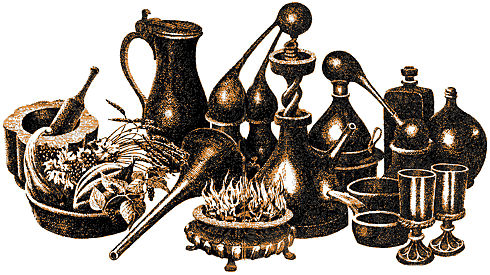
Alchemy is concerned with the creation of substances, the transmutation of elements, and the quest for immortality. It is a process by which the magical essence inherent in all things is tapped to release energy, or to mix and transmute the base elements of substances, recombining them into new substances. Alchemy has become the cornerstone of the modern world, giving rise to such wondrous substances as gunjuice, ichor fuel, lifting gases, extraordinary alloys, and miraculous medicines.
History of Alchemy
Alchemy reached its loftiest highest during the golden age of Marada. Marada was an empire driven by alchemy and over-science technology; its towering cities of brass and crystal were shadowed only by majestic floating castles, and great ships and flying machines that filled skies above. But the great war between our world and Atracus–between the Empire of Marada and the Empire of Golla, ended in the destruction of both civilizations. The myths and legends of the great alchemical miracles, empowered devices, and remarkable transmutations of the Maradian alchemist drove men for centuries after to delve into the mysteries and wonder of magic and alchemy. Yet, with nearly all the knowledge of that legendary age lost to oblivion, the alchemists of our modern age have had to start anew.
The kingdom of Valaria was founded by King Kalamon in 560 CA. During its mere 20 year existence, there was a brief revival in the study of alchemy based on what little could be recovered from the ruins of Marada. Valarian alchemists enjoyed considerable success as they begin experimenting with the transmutation of metals and compounds, as well as with new distillation techniques, and also made significant strides in medicinal elixirs. Primitive gunpowder was discovered, and although not as effective as gunjuice, it allowed for the development of matchlocks, cannons, and bombards, which were used to great effect in the War Against Nightloch.
In 730 CA, alchemists in Celanian discover the formula for gunjuice (then called red oil of charphen ester), but being a liquid, its application as a replacement for gunpowder is not immediately clear. In 848 CA, the Celanian alchemist Hemell Caveno discovered the lighter-than-air “lifting gas” later called cavenic gas, allowing for the development of airships. Through the 11th and 12th centuries, vitriolic batteries, electric and aetheric condensers, alchemical steals, and great advances in apothecary alchemy were made.
In the years 1322 to 1328 CA, the Triclopes stormed across both Tarrona and Celaphania, bringing most of the world under their control. With great courage and sacrifice, the surviving armies of Glaven, Celania, and Relmar, halted their invasion. The first firearms using gunjuice were developed during the war, as well as the first military airships, held aloft by cavenic gas. None today doubt that the War of Tyranny could have been won were it not for the new weapons and new war machines brought to bear against the Triclopes forces, many of them alchemical in nature.
The century that followed the War of Tyranny has been hailed as the Age of Progress, which has seen great strides in the advancement of science and alchemy. It was during this time that alchemists discovered the formula for creating ichor, a potent new alchemical fuel many times more efficient than even the best forms of coal and oils. Alchemists in Tilsha, Armillia, and Glaven unlocked new methods for elemental transformation, discovered crystalline-lattice metallurgy, developed potential medicinal, therapeutic, and both mental and physical enhancement elixirs. In Corradon, as well as in Kalkhemed, vast alchemical factories and refiners were constructed to produce elixirs, alchemical reagents, and other alchemical products on an industrial scale.
Today, alchemy is more important than ever and is both a necessary and vital part of modern civilization. Without alchemy, there would be no electricity, no gunjuice, no ichor fuel, no healing balms, no rejuvenating elixirs, and no great advances in materials and metallurgy. Alchemy transformed the world we have today, and it is alchemy that will formulate the world of tomorrow.

Alchemical Compounds
The following is a list of some of the more common or important alchemical substances and compounds.
Acids
Acids are a class of alchemical solutions that burn, corrode, or dissolve other substances. Diluted forms have a sour taste, similar to vinegar, which is itself a mild acid. Examples of acids include aqua vitriol, aqua fortis, and muriatic acid. Alkahest is technically an acid as well, but, being the universal solvent, is generally considered apart from (and superior to) acids in general.
Alkahest
Alkahest is the universal solvent, capable of dissolving nearly other substances, including gold, with the sole exceptions of platinum and severite. The formula for creating alkahest is a closely guarded secret, but the formulation is believed to involve aqua vitriol, antimony, quicksilver, orichalium, phosphorous, and phlogiston, combined in a complex distillation and sublimation processes. In its liquid form, alkahest can dissolve any substances except platinum and severite, and must be held in vessels lined with either platinum or severite. Crystallized (it takes nearly a gallon to produce a single crystal grain), alkahest is stable and safe to transport and store until used. These tiny granules of crystalized alkahest serve as a primary catalyst in many alchemical reactions.
Alkali
Alkalis are a class of alchemical salts, considered to be opposite of acids such as aqua vitriol, aqua fortis, and muriatic acid. Examples of alkalis include potash, quicklime, and soda. Alkalis are as often used in alchemical reactions as acids, and can be used in reactions to neutralizes acids. High concentrations of alkali are often referred to as caustic alkali, such as caustic soda.
Antimony
Antimony is a soft, silvery metal, easily made into a powder or dissolved in acid. Whether powdered or dissolved into a solution, antimony is an indispensable component in the alchemical process, and called for in many different recipes.
Aqua Vitriol

Aqua vitriol is a common acid used to dissolve substances or used in combination with other alchemicals. It is a key component in the production of gunjuice, and by itself is highly corrosive. Aqua vitriol is somewhat costly, but it can be found in alchemical shops in most cities.
Aqua Fortis
Like aqua vitriol, aqua fortis is a volatile acid most often used to create other alchemical compounds and is also a key component of gunjuice. Aqua fortis is also known as azotic acid.
Azotic Gas
Azotic gas is a primary component of common air, together with phlogiston and perhaps a few other gases. Isolated, azotic gas smothers flame and causes suffocation. It is thus, a-zotic, meaning without life. Azotic gas is also released from some reactions of aqua fortis, for which reason aqua fortis is also known as azotic acid.
Caustic Soda
Caustic soda is a common and potent alkali. Also known as lye, caustic soda is corrosive and dangerous in its concentrated form, and is general used in various degrees of dilution. Caustic soda is a key component of many different alchemical reactions.
Cavenic Gas
Cavenic gas is a lighter-than-air gas extracted by dissolving metal in aqua vitriol or, more recently, by passing electrical current through water. It is named for its discoverer, Hemell Caveno, who in 848 CA found that gas could be extracted by reacting aqua vitriol with metal.
Charphen Oil
Charphen oil is produced in the fibrous veins of the charphen tree (sometimes called the oil tree) and is commonly used as lamp oil, lubricant, a fire starter, and so forth. It may also be refined into ichor fuel or gunjuice.
Cinnabar
Cinnabar is a bright red mineral ore from which quicksilver is extracted. Quicksilver is produced from cinnabar through a process of grinding, heating, smelting, and separating. Cinnabar is also found in small quantities in dragon’s blood, and dragons appear to eat cinnabar rocks. It is not known what advantage cinnabar, or quicksilver, has for dragons, but it may enhance some of their magical abilities.
Fulminating Quicksilver
Fulminating quicksilver has been known and used by mages and alchemists for hundreds of years to great and spectacular effect. All one must do is throw the crystal at a foe; if the resulting explosion does not kill or wound him, he will certainly be shaken, if not terrified. Today, it is most often found in impact detonators for larger explosive devices. Fulminating quicksilver is created by mixing quicksilver with aqua fortis and alcohol.
Gunpowder
Sulfur-charcoal-saltpeter type gunpowder was invented and used to a limited extent during the 400s, and more extensively through the 500s and beyond, in various primitive matchlock and snaplock firearms. Whitepowder type gunpowder was invented during the 700s and lead to more advanced snaplock and caplock weapons. The formula for whitepowder requires aqua vitriol and aqua fortis to be combined with cotton, sawdust, ground-up cornhusks, or other granular plant matter. Today, both white and black gunpowders are almost entirely supplanted by gunjuice, although gunpowder does still exist for use in older and cheaper matchlock and snaplock weapons.
Gunjuice

The alchemical term for gunjuice is red oil of charphen ester, but even most alchemists simply refer to it as gunjuice in all but the most technical writings. Gunjuice (at one time also called flashjuice) is made from distillate of charphen oil (same source as ichor), reacted with fuming aqua fortis (red fumes), concentrated aqua vitriol, and a small amount of stabilizing compound such as soda ash or potash. For use in bombs and grenades, niter is also added to increase its “brisance,” or shattering effect. Gunjuice is far superior to gunpowder, being cleaner, more potent, more versatile, and smokeless. It is notably less stable, however, and the gelled form, called gungel, has improved stability while sacrificing potency. Gungel is primarily used for the charges on cannons and artillery.
Ichor Fuel
Ichor is an explosive, volatile fuel that has been alchemically refined from charphen oil. Technically called green oil of charphen ester, the basic formula calls for refined charphen oil to be mixed with aqua fortis and several other alchemical reagents, including vitriolic ethynate. The mixture is then heated under high pressure and is combined with aqua phlogista. The result of this refining process is a clear green liquid that is stable, but highly volatile when ignited. As a liquid, it burns extremely hot. As a gas, it is highly explosive. Fully refined ichor has a distinct aqua-green color and is both slippery and oily to the touch. Today it is used in modern ichor engines, typically found in aeronefs and vehicles.
Phlogiston
Phlogiston is a flammable gas found in common air, but which can also be obtained from water by electrolysis. It can also be obtained by heating chlorate of potash. In its pure, isolated form it is extremely explosive and flammable, but is often called for in highly reactive alchemical processes. It can be infused within an aqueous solution, called aqua phlogiston, which is a concentrated liquid form used for storage, handling, and processing. However, aqua phlogiston is highly volatile.

Quicklime
Quicklime is a common alkali powder, and although it is often used simply to neutralize acids, it is especially noted for its tendency to rapidly heat when mixed with water. Quicklime is created by calcinating limestone, and is widely available, and inexpensive. As a result, quicklime is called for in most alchemical recipes, whether for neutralizing acid, heating solutions, or providing its own alkali material to the mixture.
Quicksilver
Quicksilver is one the chief alchemical metals, and because its remarkable property to be both a metal and a liquid at room temperature, is prized by alchemists. Quicksilver is combined with other reagents, such as quicklime, sulfur, ammonia, various acids, and other reagents, to create a wide variety of alchemical compounds, including fulminating quicksilver (when mixed with aqua fortis and alcohol).
Sulfur
Also known as green vitriol or brimstone, sulfur is a common alchemical reagent which is called for in a host of recipes and reactions. Sulfur can be burned, creating a noxious gas, and can also be combined with charcoal and saltpeter to make gunpowder (although gunjuice is far more effective). Burning and combining with water, it will create the aqua vitriol, which is an invaluable reagent for countless alchemical processes. Sulfur is also used as a component of processing many other alchemical metals and powders.
Volatilis Ammoniac
Volatilis ammoniac is also called “dragon’s fire” because of its similarity to the volatile acids found in the belly of dragons. Volatilis ammoniac will only explode when ignited by a larger explosive—usually gunjuice or fulminating quicksilver. It is most commonly used in aerial bombs or as a stationary explosive.